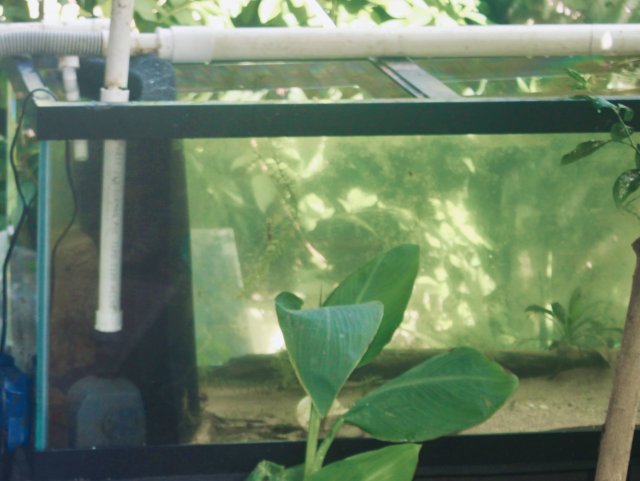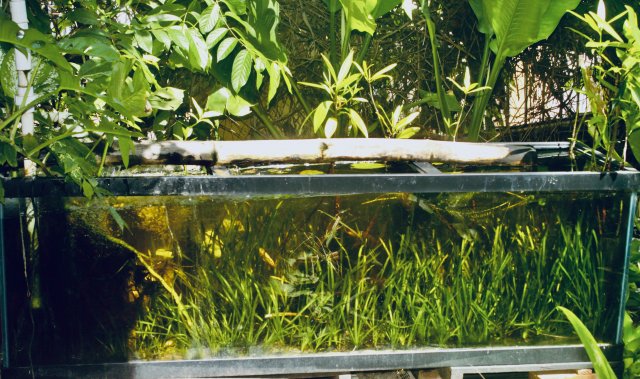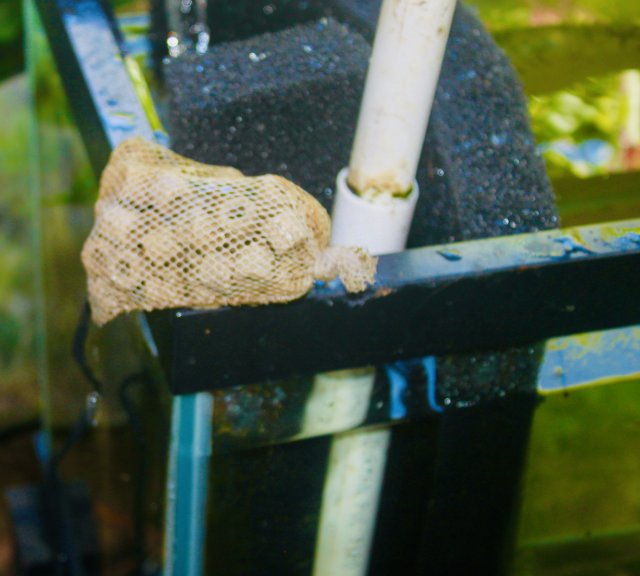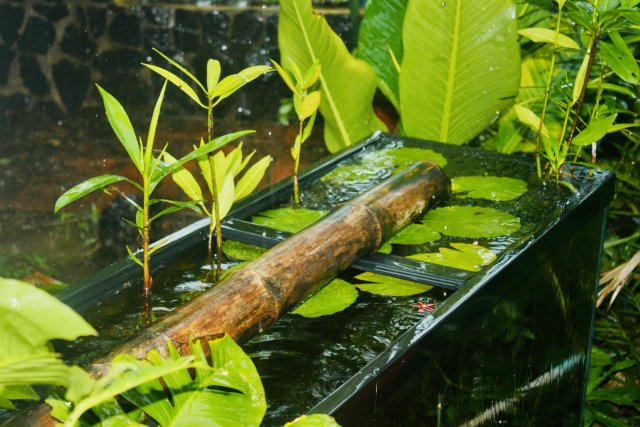Ok so random question, laying awake late at night thinking about fish, as you do!  it occurred to me that given bacteria in tank/sump will only multiply to a level that the waste in tank can sustain/feed, why do we load up our sumps with so much expensive bio media? Surely the amount of bacteria required for a given number of fish would be housed in far less or even on cheaper foam pads. Some will claim low flow areas at centre of bio media, but surely the 2 inches of sand over floor of aquarium has masses of low flow anaerobic capacity? Just a thought and would love to hear peoples take on this.
it occurred to me that given bacteria in tank/sump will only multiply to a level that the waste in tank can sustain/feed, why do we load up our sumps with so much expensive bio media? Surely the amount of bacteria required for a given number of fish would be housed in far less or even on cheaper foam pads. Some will claim low flow areas at centre of bio media, but surely the 2 inches of sand over floor of aquarium has masses of low flow anaerobic capacity? Just a thought and would love to hear peoples take on this. 
Bio media?
- Thread starter Farmerjones
- Start date
You are using an out of date browser. It may not display this or other websites correctly.
You should upgrade or use an alternative browser.
You should upgrade or use an alternative browser.
I agree with your assertion.
To me excess bio-media, is a waste of space, for the very reason you mention, because the volume of fish waste is what controls the bacterial population, not the amount of media itself.
And that expensive media doesn't reform any better than lava rock, or old toothbrushes .
I fill only about a 1/8 section of my sump with mechanical and bio-media, the other 7/8 is filled with plants (aquatic, semi-aquatic, and even terrestrial.
I use a 125 tank as a sump for my 180 gal.

When 1st set up (above) you can see the space allotted for the pump, a couple bags of media, and a wall of Porret foam, and mechanical.
Below, the same sump as it is today.

Even trace amounts of ammonia , or spikes even during heaving feedings are non-existent, and nitrate remains mostly undetectable.
At its most heavily populated state, the tank held a dozen Andinoacara cichlids (@ 5-7") a few 4" tetras, a 10" marble goby, an 8" pleco, and a 6" Awaous copy, still no detectable nitrate, when our water plant went out of service and water changes were impossible for 2 months. (except during rain storms)


To me excess bio-media, is a waste of space, for the very reason you mention, because the volume of fish waste is what controls the bacterial population, not the amount of media itself.
And that expensive media doesn't reform any better than lava rock, or old toothbrushes .
I fill only about a 1/8 section of my sump with mechanical and bio-media, the other 7/8 is filled with plants (aquatic, semi-aquatic, and even terrestrial.
I use a 125 tank as a sump for my 180 gal.

When 1st set up (above) you can see the space allotted for the pump, a couple bags of media, and a wall of Porret foam, and mechanical.
Below, the same sump as it is today.

Even trace amounts of ammonia , or spikes even during heaving feedings are non-existent, and nitrate remains mostly undetectable.
At its most heavily populated state, the tank held a dozen Andinoacara cichlids (@ 5-7") a few 4" tetras, a 10" marble goby, an 8" pleco, and a 6" Awaous copy, still no detectable nitrate, when our water plant went out of service and water changes were impossible for 2 months. (except during rain storms)


Agreed, many people seem to fixate on bio-media, many having enough bio-media in their system to support a small pony.
IME most lava rock will gunk up too easily, and requires a power cleaning to keep clean. I have been using the same Hagen/Fluval biomax rings, and later Seachem Matrix, enclosed in media bags for decades now. All it gets is a quick clean and rinse in a pail of dechlorinated tap water when doing filter cleaning and it keeps going & going & going. I have Biomax rings that are now close to 25 yrs old, and still doing their job. I find that they require less maintenance than lava rock, and I scored them for next to nothing at a local auction, so win-win for me.
IME most lava rock will gunk up too easily, and requires a power cleaning to keep clean. I have been using the same Hagen/Fluval biomax rings, and later Seachem Matrix, enclosed in media bags for decades now. All it gets is a quick clean and rinse in a pail of dechlorinated tap water when doing filter cleaning and it keeps going & going & going. I have Biomax rings that are now close to 25 yrs old, and still doing their job. I find that they require less maintenance than lava rock, and I scored them for next to nothing at a local auction, so win-win for me.
Nearly wet myself at little pony comment  I'm the same, seachem matrix and fluval rings over 10 years old and still working like a charm.
I'm the same, seachem matrix and fluval rings over 10 years old and still working like a charm.
I think a lot of people seem to buy biomedia the same way they buy filters and other gear: to show off to other gearheads! These nerds apparently think that looking at filters and sumps is the sexiest part of the hobby; sometimes I wonder why they actually bother with the fish...
I use a bunch of fluidized K1 for two reasons: firstly, because I got it essentially for free...and secondly, because my granddaughters love watching it wiggle and dance in the filter! Otherwise, I want the cheapest, lightest, longest-lasting and most easily cleaned stuff I can get. Poret foam, while relatively expensive as foam goes, lasts forever and is pretty easy to clean. And my favourite biomedia is a big bag full of plastic shotshell wads, which weight almost nothing, cost almost nothing, last forever and rinse off in seconds. Still needs the foam or some other medium for mechanical filtration.
And absolutely, even the "worst" biomedia still have enough surface area to culture enough bacteria for almost any tank, even in much smaller quantities than most people use. I mean, aquariums can be successfully maintained when all the biological medium they have is the pitifully small amount that can be jammed into a canister filter. So, why do all the sump people use 10x as much?
Well...because we can! A sump gives us the space for a huge amount of biomedia. The bacterial colony, although limited by bioload, is spread out over a much larger area, and that makes it easy to steal a good quantity of mature, cycled media to start new tanks. Sure, you might be removing 25% or 50% of the bacteria in your donor tank. Big deal; feed it lightly or not at all for a day or two, and the bacterial generation time is so fast that it will be back up to full capacity by that time.
Having a large quantity of biomedia also makes it possible to clean it in stages, only rinsing off a portion at a time, in case you are worried about swishing away or killing all your bacteria if you do it all at once. This is a totally imaginary concern unless you are cleaning the stuff in hot tap water, but it makes some people feel more relaxed.
I use a bunch of fluidized K1 for two reasons: firstly, because I got it essentially for free...and secondly, because my granddaughters love watching it wiggle and dance in the filter! Otherwise, I want the cheapest, lightest, longest-lasting and most easily cleaned stuff I can get. Poret foam, while relatively expensive as foam goes, lasts forever and is pretty easy to clean. And my favourite biomedia is a big bag full of plastic shotshell wads, which weight almost nothing, cost almost nothing, last forever and rinse off in seconds. Still needs the foam or some other medium for mechanical filtration.
And absolutely, even the "worst" biomedia still have enough surface area to culture enough bacteria for almost any tank, even in much smaller quantities than most people use. I mean, aquariums can be successfully maintained when all the biological medium they have is the pitifully small amount that can be jammed into a canister filter. So, why do all the sump people use 10x as much?
Well...because we can! A sump gives us the space for a huge amount of biomedia. The bacterial colony, although limited by bioload, is spread out over a much larger area, and that makes it easy to steal a good quantity of mature, cycled media to start new tanks. Sure, you might be removing 25% or 50% of the bacteria in your donor tank. Big deal; feed it lightly or not at all for a day or two, and the bacterial generation time is so fast that it will be back up to full capacity by that time.
Having a large quantity of biomedia also makes it possible to clean it in stages, only rinsing off a portion at a time, in case you are worried about swishing away or killing all your bacteria if you do it all at once. This is a totally imaginary concern unless you are cleaning the stuff in hot tap water, but it makes some people feel more relaxed.
I haven’t used a sump, just HOBs and canisters, I don’t use HOBs with cartridges, just the Aqua clear and those types, but as far as media, I usually just use what they come with and I might add sponges. That’s always worked fine for me
Ok so random question, laying awake late at night thinking about fish, as you do!it occurred to me that given bacteria in tank/sump will only multiply to a level that the waste in tank can sustain/feed, why do we load up our sumps with so much expensive bio media? Surely the amount of bacteria required for a given number of fish would be housed in far less or even on cheaper foam pads. Some will claim low flow areas at centre of bio media, but surely the 2 inches of sand over floor of aquarium has masses of low flow anaerobic capacity? Just a thought and would love to hear peoples take on this.

You are correct.
I should add - there is a possibility that more biomedia (or surface area rather) may have some benefits. Population growth of microorganisms can be slower if the concentration of cells within an area is higher, as the cells compete against each other for the same resources. However, more surface area may mean ultimately the nitrifiers are more spread out, hence if there is ever a need for the population to increase in size, it may be faster with more biomedia (or surface area rather). This translates to an aquarium potentially responding faster to ammonia/nitrite spikes, i.e. potentially safer for fish. But this is just hypothetical - or at least, I have yet to read or see any evidence that this is a material consideration.
You are correct.We really don't need to load up our filters with biomedia. That's also why small filters now also work great, because with really good biomedia nowadays, even a small volume can work wonders. No need for canisters or sumps or anything.
"Small filters"? What are we talking about here, internal corner box filters?
The larger the filter, specifically the larger the mechanical filtration area of a filter...the more slowly it clogs and the less often it needs to be cleaned. Notice I said "needs", not "should". I like to clean my initial filtration stage very frequently, often every day, so clogging isn't a worry...but back when I was working remotely from home for three weeks at a stretch, I needed the initial stage of mechanical filtration for a non-crowded 360-gallon cichlid community to have an area of about 100-120 square inches to be able to go that long without cleaning and also without becoming clogged.
The only practical way for this to work was by using a sump. Any other style of filter has a much smaller area devoted to mechanical filtration, and clogs relatively quickly. And now, in full retirement and with lots of time to devote to my tanks, I still prefer the sump, because it is the easiest and quickest style of filter to clean. Lift the cover, pull out the top layer of foam, rinse it out, lay it back in place; 60 seconds, not including the long 10-second trek over to the slop-sink and back. Doing it daily removes a significant amount of solid waste before it even has a chance to break down and add to my nitrates.
In a sump, the pump is sitting in and drawing clean filtered water and returning it to the tank; it's always running at full flow. In a canister, the pump is forcing the tank water through the media; as the media clogs, the flow rate will gradually drop as the pump works harder and harder to overcome the resistance of increasingly-clogged mechanical media.
A smaller filter likely refers to some sort of sealed/pressurized gizmo (canister) that must be opened up to remove and clean the media...or an internal filter, and make no mistake, any filter inside the tank will be slow and sloppy to clean compared to the sump. And the smaller the filter, the more often it must be done.
I get that some folks just don't have the room, or the inclination, to use a sump; it's always fun to listen to the reasons they use to justify how their little canisters and HOB's are "just as good"...
Last edited:


